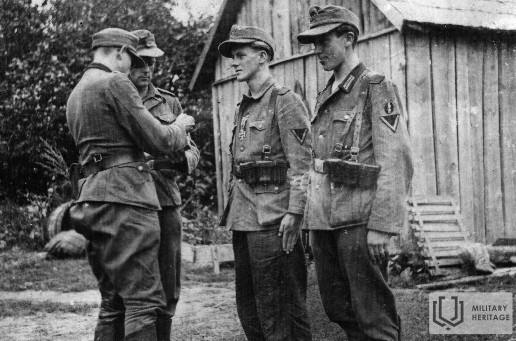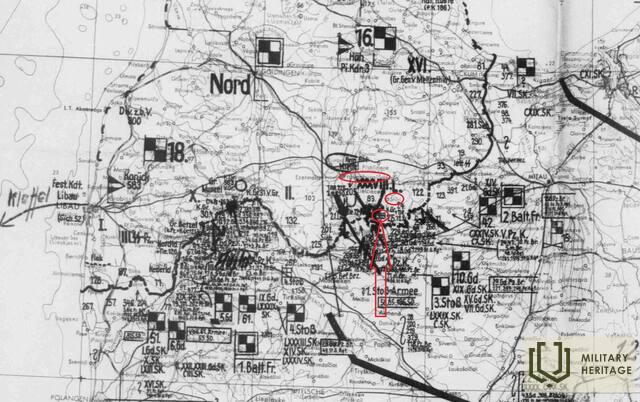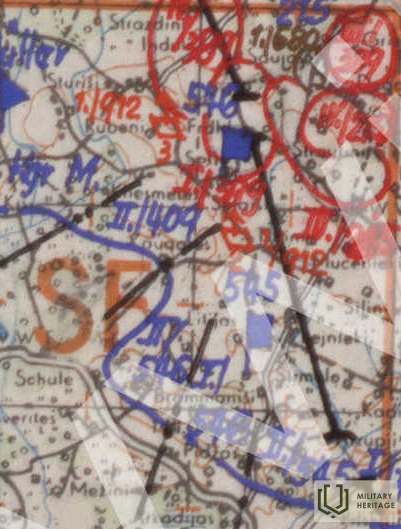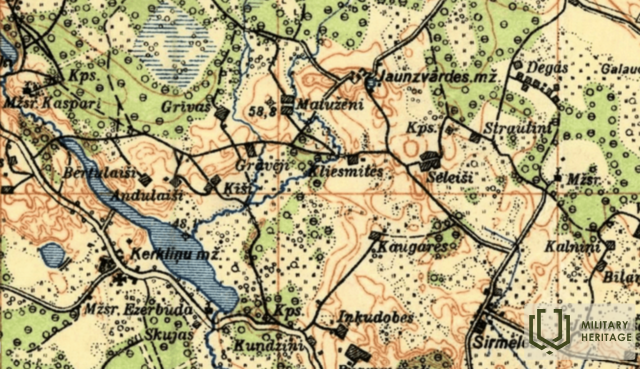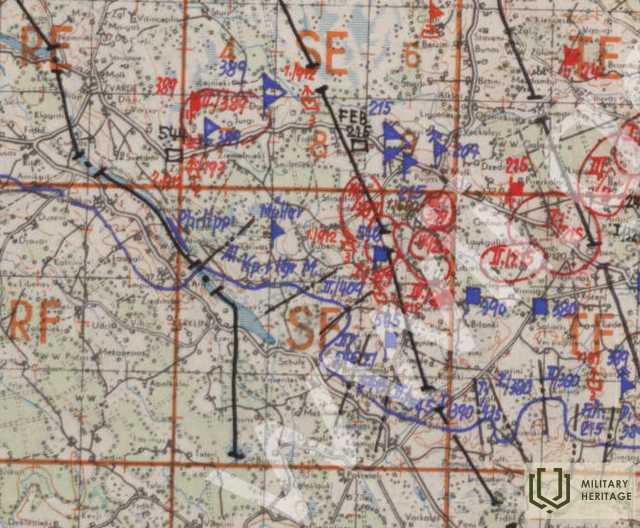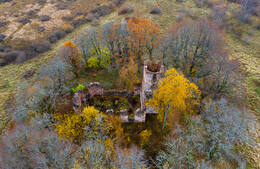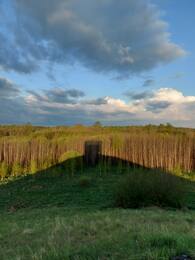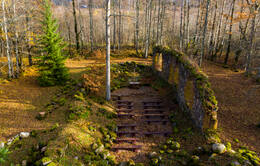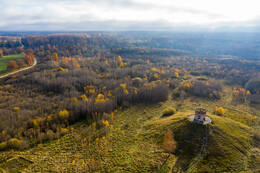German army corporal Felker's account of the reconnaissance battle on 8 and 9 November 1944 at the Selješa home in Zvārde
Felker (German: Völcker) was a 20-year-old boy, serving in an intelligence division in the Nazi German army, who narrates the events of November 8 and 9, which vividly reflect the frontline events in Zvārde, where the frontline moved back and forth for 4 months, including in the vicinity of the Ķērkliņi church.
In November 1944, our severely weakened division was regularly used as a kind of "fire brigade". Loaded into trucks, we were taken to the hottest spots, and usually had to straighten out the breaches in the front line, only to be taken elsewhere.
As it happened, I still cannot tell you where I was on the afternoon of 8 November 1944. Our regimental reconnaissance unit was camped in a shelter we called the "potato cellar". My comrade, soldier Ksedl, a sturdy fellow of 20 from Passau, was stretched out on the grass behind me and fast asleep. Ivan had taken a long break with artillery fire, and everyone took advantage of the short rest. I was sitting there splitting a stick when one Russian shell hit the valley. Nothing exciting, but I realised that our telephone lines, which were set up there, must have picked up something.
Before our commander, Dorst, could give me the appropriate order, I had already taken my repair materials, (masking tape, pliers) and reported to Dorst. I told him that he did not need to wake Private Ksedl. I could solve this small problem myself. I got down into the valley and quickly found the damaged area. I repaired the line and finally checked with my fingers if there was a flow of energy. I wanted to return to our dugout and had gone about 50 metres up the slope when our commander, Dorst, came down the slope to meet me. He was gesticulating wildly, shouting for me to run back to the forest, the Russians were breaking through. From the "potato cellar" my company comrades ran down the slope towards me, and behind them the Russian soldiers with shouts of "urräh" and heavy infantry fire.
We ran to the next wood, and there we met other, smaller units that had gathered together to help us stop the invasion, which fortunately took place without the support of tanks. It was not a major offensive, more of a shelling, but the Russian soldiers had taken the hill without too much trouble. It is probable that the Russian leadership, thanks to intelligence, had realised that our armament was more than pathetic as far as heavy weapons were concerned. We sat in the woods and watched the Russian soldiers who continued to expand their positions on the mountain. There was no way of stopping them.
Two days later, with the help of a tank unit led by Captain Furman, we were able to counter-attack, taking the high ground with the 'potato cellar'. Shortly before the spot where I had patched up the line two days before, my friend Ksedl lay, fatally shot in the head. It gave me some comfort that he probably felt nothing of his death.
Only about 70 soldiers from my division survived the war. Some, like me, with more or less serious injuries, others, like Private Ritweiler, who lost his mind in December 1944 after several hours of shelling. To this day, my memories have faded, but even today, at almost 80 years of age, they are sometimes still very intense in my dreams...
Photo (left to right): Lieutenant Ölker, Sergeant Dorst, Corporal Völcker, Soldier Rittweiler.
www.kurland-kessel.de
Related timeline
Related objects
Ruins of Ķērkliņu church
The ruins of the Ķerkliņu Church are located about 5 kilometres north-west of Kokmuiža, near the Ķerkliņu Lake. The church was built in 1641 by Heinrich von Dönhoff (Derkarth), the owner of the Ķerkliņi manor. The original wooden church was replaced by a stone building, under which tombs were built for the dead of the Dönhof and later Kleist families. The tombs were already destroyed during the 1905 riots, but in 1949 the coffins were moved from the tombs to the church. The church was an example of the Kurzeme Baroque style - its carvings were made by the Kuldīga - Liepāja woodcarvers. Although the owners of the manor and the church were at various times plagued by financial problems, the church underwent several reconstructions during its existence. It also suffered during the First World War, after which the parish rebuilt the stonework in 1929 and added an organ in 1934. Unfortunately, the church was damaged during the Second World War and much of it was lost, so it is to be commended that before the church was rebuilt in 1933, many unique pieces of Baroque sculpture were photographed, inventoried and even ended up in the archives of the Monuments Board. With the establishment of the landfill and the eviction of the inhabitants, the church was never restored. Today, the church walls and tower are visible.
Soviet air force target firing ground in Zvārde
Zvārde landfill is located in Zvārde municipality, Saldus region. It is a former military aviation training ground of the USSR, covering more than 24 000 hectares.
The territory of the former airfield is home to several sites: the Officers' Kurgan, the ruins of the Zvārde and Ķērkliņi churches, the Rīteļi cemetery, the former army base "Lapsas", and others. Until the Second World War, the site of the observation tower was home to the "Vairogi" house. During the construction of the polygon, what was left of the farm - walls, the remains of the apple orchard, and part of the ruins of the Veczvārde manor - was piled together to form a mound and the observation tower was built on it. It was used as an observation point for coordinating the army's training manoeuvres. This place is popularly known as Kurgan. The mound overlooks the former training ground and the wooded areas of Zvārde Nature Park and Nature Reserve. A good place for bird watching. The surroundings of Kurgāns are not landscaped.
Zvārde church ruins
The ruins of Zvārde Church are located on the territory of the former Zvārde air target range, near the so-called "Kurgan of the Officers". After a kilometre and a half, you will pass a T-junction with the Rīteļi cemetery nearby.
The first wooden church and rectory were built here in 1567, and the stone church was built in 1783 at the expense of local peasants, Kurzeme nobles and Duke of Courland Peter Byron. During the Second World War, the church roof and tower were damaged in the fighting. In 1953, when the Soviet Ministry of Defence requested the establishment of an air-target range on the site, Zvārde Church, Ķerkliņi Church and Rīteļi Cemetery were placed in the centre of the air-target range - next to an artificial airfield with access roads and defensive positions, which was used as a target by Soviet pilots. Planes flew here from airfields in Latvia and elsewhere in the Soviet Union. In less than 40 years, the church, the cemetery, the former manor house and dozens of surrounding buildings were reduced to ruins.
Soviet Army Observation Tower (Kurgan of Officers)
The "Officers' Kurgan" is located less than a kilometre from the ruins of Zvārde Church. The Kurgan is made of the ruins and remains of the surrounding houses and manor house, which have been bulldozed together. An observation tower was built on the kurgan. According to the inscription, the present tower was built in 1981. The tower was used to record bomb hits. The training bombs had a reduced explosive content, so their hits had to be watched more carefully. Unexploded bombs were neutralized immediately, but not all could be found.
The remains of the tower can be seen here today - the brick walls. As the barrage is relatively high, you can even see the Lithuanian oil refinery in Mažeikiai on a clear day.




